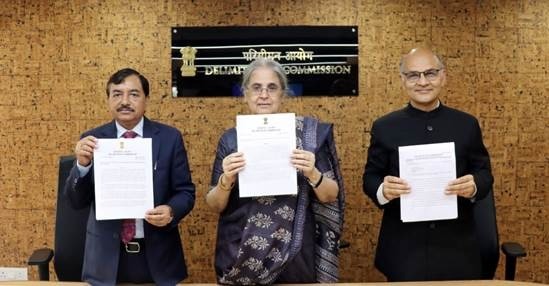After consultation with associate members, representatives of political parties, citizens and civil society groups, as many as nine assembly constituencies have been reserved for STs, out of which six are in Jammu region and three in the Valley.

New Delhi: The Delimitation Commission, which was asked to redraw the Assembly constituencies of Jammu and Kashmir, met on Thursday to finalise the Delimitation Order for the Union Territory of Jammu & Kashmir. The Gazette notification for the same has also been published on Thursday, the Election Commission of India said in a statement.
The Commission is headed by Justice Ranjana Prakash Desai, (a retired Judge of the Supreme Court of India), Sushil Chandra (Chief Election Commissioner) and K K Sharma (State Election Commissioner, Union Territory of Jammu and Kashmir) as the ex-officio members of the Delimitation Commission.
The poll panel said, of the 90 Assembly constituencies in the region, 43 will be part of the Jammu region and 47 of the Kashmir region, keeping in view the provisions of Section 9(1)(a) of the Delimitation Act, 2002 and Section 60(2)(b) of Jammu & Kashmir Reorganization Act, 2019. After consultation with associate members, representatives of political parties, citizens and civil society groups, as many as nine assembly constituencies have been reserved for STs, out of which six are in Jammu region and three in the Valley.
In a statement, the poll panel said, “Having regard to relevant provisions of the Constitution (Article 330 and Article 332) and sub-sections (6) and (7) of Section 14 of the Jammu and Kashmir Reorganisation Act 2019, the number of seats to be reserved for the Scheduled Castes (SCs) and Scheduled Tribes (STs) in the Legislative Assembly of the Union Territory of Jammu and Kashmir was worked out on the basis of 2011 Census. Accordingly, the Delimitation Commission has reserved nine ACs for STs for the first time and 07 for SCs. It is worthwhile to mention that the Constitution of erstwhile Jammu and Kashmir State did not provide for reservation of seats for the Scheduled Tribes in the Legislative Assembly.”
It added, “There are five Parliamentary Constituencies in the region. The Delimitation Commission has seen the Jammu & Kashmir region as one single Union Territory. Therefore, one of theParliamentary Constituency has been carved out combining Anantnag region in the Valley and Rajouri & Poonch of Jammu region. By this reorganisation each Parliamentary Constituency will have equal number of 18 Assembly Constituencies each. Names of some ACs have also been changed keeping in view the demand of local representatives.”
The Commission had decided that the constituencies shall be delimited with regards to the administrative units i.e. the districts, tehsils, patwar circles, etc, “as in existence on 15-06-2020 and the Commission had communicated to the Union Territory administration, not to disturb the administrative units as existing as on 15-06-2020 till the completion of the delimitation exercise in the UT of Jammu and Kashmir. It was ensured by the Commission that every Assembly Constituency shall be contained entirely in one district and the lowest administrative units i.e. Patwar Circles (and Wards in Jammu Municipal Corporation) were not broken and were kept in single Assembly Constituency”.
The Union Territory of Jammu and Kashmir was carved out from the erstwhile State of Jammu and Kashmir through the Jammu and Kashmir Reorganisation Act, 2019 (34 of 2019), passed by the Parliament. The delimitation of the Assembly constituencies in the erstwhile state of Jammu and Kashmir was governed by the Constitution of the state of Jammu and Kashmir and Jammu and Kashmir Representation of People Act, 1957. The Assembly seats in the erstwhile state of Jammu and Kashmir were last delimited in 1995 based on the 1981 census.
It may be recalled that the Delimitation Commission was constituted by the Government of India, in exercise of powers conferred by Section 3 of Delimitation Act, 2002 (33 of 2002), for the purpose of delimitation of Assembly and Parliamentary Constituencies in the Union Territory of Jammu & Kashmir. The Commission associated in its work five members of Lok Sabha elected from the Union Territory of Jammu and Kashmir. These Associate Members were nominated by the Speaker of Lok Sabha.
